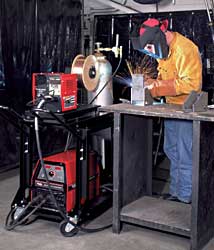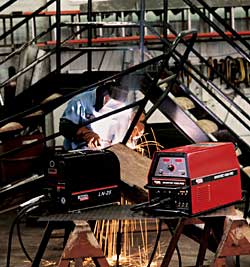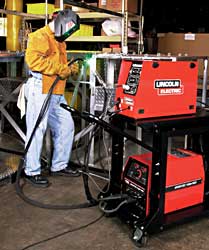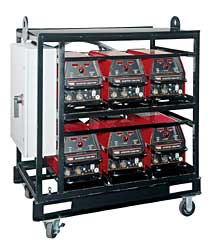Energy Efficiency: Inverter Power Source
The advantages of inverter welding units over traditional transformer-rectifiers are many. Inverters are more portable and lighter weight, making them easier to maneuver around the job site. In addition, inverters offer high-quality, multi-process welding capabilities so that one machine can handle Stick, MIG, TIG, FCAW, arc gouging and even pulsing. And even more importantly, inverters take advantage of Lincoln's Waveform Control Technology™ to offer greater control of arc variables and automatically fine tune the arc to create the best possible weld, controlling problems such as burnthrough.
But did you know that using an inverter can also save you money in energy costs over a traditional-type power source? Each year about $15 million worth of electricity is consumed in the U.S. and $99 million worldwide for welding. To increase efficiencies and cut down on the money your company is spending on electricity related to welding, an inverter is an attractive option. In fact, because of their efficiency, these machines can provide substantial savings in utility costs.
But how can a switch to an inverter save in energy consumption? In the design of inverter welders, such as Lincoln's Invertec® V350 Pro, the transformer cores, transformer windings and power electronic switching components are all carefully chosen to minimize operating losses. Here are some other reasons that inverters save in energy costs:
- Greater transformer efficiencies are realized through the use of ferrite cores in the inverter's power transformer. This reduces the current losses resulting in lower idle currents in the supply conductors
- The inverter transformer coils are physically smaller than common transformers. A smaller coil translates to less wire wrapping around the core - less wire
means fewer losses and greater efficiency
- The inverter's power electronic components have been carefully designed to reduce losses and extend operating life
- Many inverters, such as Lincoln's Invertec V350 Pro, uses a copper conductor. Copper has higher thermal and electrical conductivity compared to aluminum,
which will minimize losses and maximize efficiency
- Operating at higher frequencies than conventional welders, inverters require less output inductance for smooth operation. The energy needed for stick welding or for globular transfer welding processes is stored in capacitors allowing for smaller output chokes
- The compact design and relatively small physical size of an inverter welder means shorter leads and cables (or even direct connections) between power
components. Shorter current paths translate to lower resistances and better efficiencies
- Because the inverter is designed to inherently have low losses, smaller cooling fans are required. This means less power is needed for moving cooling air and, again, greater efficiency
- The smaller size of the components inside the inverter machine translate into less heat to dissipate and again, greater efficiency
How can you calculate how an inverter can save you money over a traditional transformer- rectifier and which inverter is the best in creating energy efficiencies? Use the worksheet below to make that assessment.
Step #1 - Calculate Output Power
First look at your machine to determine the output voltage (Vout) which is given as volts on your machine. In our example this is 32v. Then multiply that by the output current (Iout), found on your machine in amps. In this case the amps are given as 300.
Vout x Iout = Output Power (Wout) in watts
32v x 300 amps = 9,600 watts OR 9.6 KW (1,000 watts = 1 KW)
Step #2 - Calculate Input Power
Now take the output power from above (KWout) and divide by the efficiency (Eff). The efficiency is given by the machine's manufacturer. Calculating this will give you input power in kilowatts.
KWout ÷ Eff = Input power in kilowatts (KWin)
9.6 KW ÷ 88.2% (or 0.882) = 10.88 KW
Step #3 - Calculate Operating Costs During Welding
A) Next, you will calculate the kilowatt hours used in one day (KWh1/day) by taking the input power calculated in Step #2 (KWin) multiplied by the hours per day that the machine runs (for our example, we will assume welding is performed four hours per day.)
KWin x #Hrs/Day = Kilowatt hours used in one day (KWh1/day)
10.88 KW x 4 Hrs. = 43.52 KWHrs/day
B) Now take your input power calculated (KWin) multiplied by the number of hours per day the machine runs multiplied by the price per KW hour of the power. Note: the price of the power is calculated at $0.12578 which is the industry average.
KWin x #Hrs/Day x Price per KWHrs ($/KWh) = Daily Operating Costs Welding
10.88 x 4 x $0.12578 = $5.47
Step #4 - Calculate the Operating Costs During Idle
A) You will now calculate the idle consumption per day (KWh2). To do this, take the input power (KWIdle) multiplied by the idle hours per day. (We are assuming that in an eight-hour day, if welding is performed four hours, idle hours will be four as well.)
KWIdle x Idle Hrs. = Idle Consumption Per Day (KWh2)
0.4 KW x 4 Hrs. = 1.6 KW hrs
B) Now take the input power idle (KWIdle) which is given on the power transformer in watts - in this case 400 watts (or 0.4 KW) - multiplied by the idle hours x the price per kilowatt hour of power.
KWidle x IdleHrs x Price per KW Hrs = Daily Operating Costs Idle
0.4 KW x 4 Hrs. x $0.12578 = $0.20
Step #5 - Calculate the Total Operating Costs
Now take the daily operating costs welding calculated in Step #3 and add the daily operating costs idle from Step #4 above equals the daily operating costs in dollars.
Daily Operating Costs + Daily Operating Costs Idle = Daily Operating Costs (Total $/day)
$5.47 + $0.20 = $5.67
By comparing this number against a traditional transformer-rectifier or another competitive inverter, you can easily tell which machine will provide the cost savings.
An inverter with a list price of $3,200 and efficiency of 87 percent compared to a traditional transformer rectifier that has a list price of $2800 and a 67 percent efficiency rate would save approximately $300 in utility cost on an annual basis. The payback for the difference in price would then be in one to one-and-a-half years.




